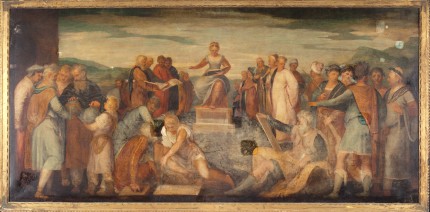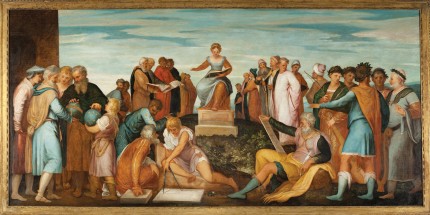A massive work by 16th century Dutch painter Lambert Sustris has been restored to its original splendor and will go on display for the first time in years at Vassar College’s Frances Lehman Loeb Art Center in Poughkeepsie, New York.
The oil-on-canvas painting is of monumental size (5’6″ high by 11’6″ wide) and was originally one of a series of five canvas murals that adorned the walls of a palazzo in Venice. It depicts a scene from the Tabula Cebetis, a philosophical allegory traditionally attributed to Cebes of Thebes (430-350 B.C.), a disciple of Socrates who appears in Plato’s Phaedo, but which in fact was written by an unknown author in the 1st century or 2nd century A.D. In dialogue form, the text describes an allegorical image deposited in the Temple of Chronos that presents Life as three concentric circles replete with obstacles that individuals have to surmount to reach True Education and her gift of Knowledge. False Education is in the second circle. She looks attractive and well put together, but she can’t give seekers real knowledge. They have to overcome the more subtle evils of the second circle and find the strength to climb the narrow, steep path towards True Education or else they’ll be eternally trapped in error by their own laziness and corruptibility.
 While widely known in antiquity and still copied by Muslim scholars in the 9th century, European intellectuals rediscovered the Tabula Cebetis when a Latin prose translation by Odaxius was published in 1497. Lambert Sustris was born in Amsterdam 20 or so years later (between 1515 and 1520). His early education isn’t known, but he we know he visited Rome as a youth because the scamp graffitoed his name on the walls of Nero’s Domus Aurea. By 1535 Sustris was working in Venice, doing landscapes for Titian’s studio. He and Titian became friends and traveled together to Germany twice in 1548 and 1550 where they painted the Holy Roman Emperor Charles V and other notables during sessions of the Diet of Augsburg.
While widely known in antiquity and still copied by Muslim scholars in the 9th century, European intellectuals rediscovered the Tabula Cebetis when a Latin prose translation by Odaxius was published in 1497. Lambert Sustris was born in Amsterdam 20 or so years later (between 1515 and 1520). His early education isn’t known, but he we know he visited Rome as a youth because the scamp graffitoed his name on the walls of Nero’s Domus Aurea. By 1535 Sustris was working in Venice, doing landscapes for Titian’s studio. He and Titian became friends and traveled together to Germany twice in 1548 and 1550 where they painted the Holy Roman Emperor Charles V and other notables during sessions of the Diet of Augsburg.
Sustris painted The Circle of False Education during his time in Venice. The vast canvas was created from two horizontal pieces of fabric blanket stitched together. It was affixed to the wall for hundreds of years before it was removed, stretched and secured to glue and canvas linings. Conservators believe the stretcher dates to the 19th century and the painting hasn’t been restored since then either, so it’s likely the owners of the Venetian palazzo stripped the murals off their walls and sold them 150 or so years ago.
The painting was gifted to Vassar College by Charles M. Pratt in 1917. It’s been in such bad condition, discolored by old varnish and overpaint, for so long that it was kept in storage and hasn’t been seen in public for years. The Frances Lehman Loeb Art Center enlisted the aid of experts at the Williamstown Art Conservation Center in Massachusetts to get the mural back in display condition. Paintings conservator Sandra Webber feared the worst when she saw the darkened surface the tell-tale whitened areas of severely blanched varnish. Her concerned was that the original paint underneath the discolored varnish was lost beyond redemption.
Cleaning tests revealed that pale pinks, brilliant blues, greens and oranges were still strong underneath the varnish, so conservators made an 18-month restoration plan that would revive the obscured colors. The first phase was to remove the varnishes and coatings and all the overpaint that could be safely removed. The cleaning process revealed a number of ills — later additions like mountains, probably meant to cover paint loss from the original clouds, in the background, tears and tugs from when the canvas was pulled off the wall, several larger holes that may have been original to fit the canvas around architectural details — but Webber was confident they could be repaired.
After the discolored layers were removed and the original paint exposed, the second phase of conservation began. This phase focused on reconstructing the image, filling areas of loss with a custom putty and acrylic paints matching Sustris’ original palette. Conservators believe the colors were chosen deliberately because they evoke frescoes. Fresco, bright pigments applied over a layer of wet plaster, doesn’t work very well in high humidity environments like cities built on lagoons, so it’s likely that the canvas mural was chosen as a more viable alternative to frescoes in perpetually moist Venice.
And now, the whole point of this post, the before and after pictures!


You might notice the figures are not highly detailed. That’s because the mural wasn’t meant to be seen up close. The change in color is one for the ages, in my opinion, especially the heavily blanched areas like the hill False Education sits upon.